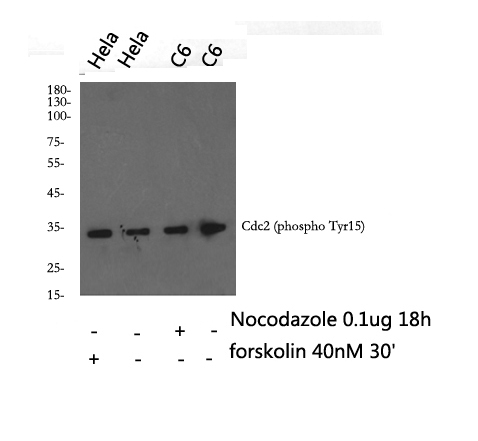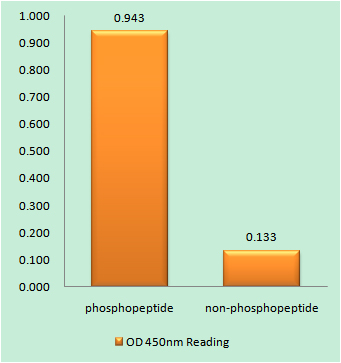Cdc2 (phospho Tyr15) Polyclonal Antibody
- Catalog No.:YP0054
- Applications:WB;ELISA
- Reactivity:Human;Mouse;Rat;Monkey
- Target:
- CDK1/CDC2
- Fields:
- >>Cell cycle;>>Oocyte meiosis;>>p53 signaling pathway;>>Cellular senescence;>>Gap junction;>>Progesterone-mediated oocyte maturation;>>Human immunodeficiency virus 1 infection;>>Viral carcinogenesis
- Gene Name:
- CDK1
- Protein Name:
- Cyclin-dependent kinase 1
- Human Gene Id:
- 983
- Human Swiss Prot No:
- P06493
- Mouse Gene Id:
- 12534
- Mouse Swiss Prot No:
- P11440
- Rat Gene Id:
- 54237
- Rat Swiss Prot No:
- P39951
- Immunogen:
- The antiserum was produced against synthesized peptide derived from human CDC2 around the phosphorylation site of Tyr15. AA range:5-54
- Specificity:
- Phospho-Cdc2 (Y15) Polyclonal Antibody detects endogenous levels of Cdc2 protein only when phosphorylated at Y15.
- Formulation:
- Liquid in PBS containing 50% glycerol, 0.5% BSA and 0.02% sodium azide.
- Source:
- Polyclonal, Rabbit,IgG
- Dilution:
- WB 1:500 - 1:2000. ELISA: 1:10000. Not yet tested in other applications.
- Purification:
- The antibody was affinity-purified from rabbit antiserum by affinity-chromatography using epitope-specific immunogen.
- Concentration:
- 1 mg/ml
- Storage Stability:
- -15°C to -25°C/1 year(Do not lower than -25°C)
- Other Name:
- CDK1;CDC2;CDC28A;CDKN1;P34CDC2;Cyclin-dependent kinase 1;CDK1;Cell division control protein 2 homolog;Cell division protein kinase 1;p34 protein kinase
- Observed Band(KD):
- 34kD
- Background:
- cyclin dependent kinase 1(CDK1) Homo sapiens The protein encoded by this gene is a member of the Ser/Thr protein kinase family. This protein is a catalytic subunit of the highly conserved protein kinase complex known as M-phase promoting factor (MPF), which is essential for G1/S and G2/M phase transitions of eukaryotic cell cycle. Mitotic cyclins stably associate with this protein and function as regulatory subunits. The kinase activity of this protein is controlled by cyclin accumulation and destruction through the cell cycle. The phosphorylation and dephosphorylation of this protein also play important regulatory roles in cell cycle control. Alternatively spliced transcript variants encoding different isoforms have been found for this gene. [provided by RefSeq, Mar 2009],
- Function:
- catalytic activity:ATP + [DNA-directed RNA polymerase] = ADP + [DNA-directed RNA polymerase] phosphate.,catalytic activity:ATP + a protein = ADP + a phosphoprotein.,enzyme regulation:Phosphorylation at Thr-14 or Tyr-15 inactivates the enzyme, while phosphorylation at Thr-161 activates it.,function:Plays a key role in the control of the eukaryotic cell cycle. It is required in higher cells for entry into S-phase and mitosis. p34 is a component of the kinase complex that phosphorylates the repetitive C-terminus of RNA polymerase II.,similarity:Belongs to the protein kinase superfamily.,similarity:Belongs to the protein kinase superfamily. CMGC Ser/Thr protein kinase family. CDC2/CDKX subfamily.,similarity:Contains 1 protein kinase domain.,subunit:Forms a stable but non-covalent complex with a regulatory subunit and with a cyclin. Interacts with DLGAP5. Isoform 2 is unable to complex with c
- Subcellular Location:
- Nucleus. Cytoplasm. Mitochondrion . Cytoplasm, cytoskeleton, microtubule organizing center, centrosome . Cytoplasm, cytoskeleton, spindle. Cytoplasmic during the interphase. Colocalizes with SIRT2 on centrosome during prophase and on splindle fibers during metaphase of the mitotic cell cycle. Reversibly translocated from cytoplasm to nucleus when phosphorylated before G2-M transition when associated with cyclin-B1. Accumulates in mitochondria in G2-arrested cells upon DNA-damage.
- Expression:
- Isoform 2 is found in breast cancer tissues.
5,6-Dihydroxy-3,7,4′-trimethoxyflavonol induces G2/M cell cycle arrest and apoptosis in human hepatocellular carcinoma cells. JOURNAL OF ASIAN NATURAL PRODUCTS RESEARCH J Asian Nat Prod Res. 2016;18(11):1079-1090 WB Human 1:1000 HepG-2 cell
5, 6-Dihydroxy-3, 7, 4′-trimethoxyflavonol induces G2/M cell cycle arrest and apoptosis in human hepatocellular carcinoma cells." Journal of Asian natural products research 18.11 (2016): 1079-1090.
- June 19-2018
- WESTERN IMMUNOBLOTTING PROTOCOL
- June 19-2018
- IMMUNOHISTOCHEMISTRY-PARAFFIN PROTOCOL
- June 19-2018
- IMMUNOFLUORESCENCE PROTOCOL
- September 08-2020
- FLOW-CYTOMEYRT-PROTOCOL
- May 20-2022
- Cell-Based ELISA│解您多样本WB检测之困扰
- July 13-2018
- CELL-BASED-ELISA-PROTOCOL-FOR-ACETYL-PROTEIN
- July 13-2018
- CELL-BASED-ELISA-PROTOCOL-FOR-PHOSPHO-PROTEIN
- July 13-2018
- Antibody-FAQs
- Products Images

- Western blot analysis of lysates from Mouse-brain, Rat-brain, Hela cells treated with nocodazole 1ug/ml 18h, using CDC2 p-Thr15 Antibody. Primary Antibody was diluted at 1:1000 4° over night,secondary antibody(Immunoway cat:RS23710)was diluted at 1:10000, 37° 1hour.

- Western blot analysis of Cdc2 (phospho Tyr15) Polyclonal Antibody, using Hela, C6 cell treated or untreated with forskolin 40nM 30', Nocodazole(Immunoway cat#:MC0250) 0.1ug/ml 18hour, 4° over night, secondary antibody(cat: RS0002 was diluted at 1:10000, 37° 1hour.

- Enzyme-Linked Immunosorbent Assay (Phospho-ELISA) for Immunogen Phosphopeptide (Phospho-left) and Non-Phosphopeptide (Phospho-right), using CDC2 (Phospho-Tyr15) Antibody



